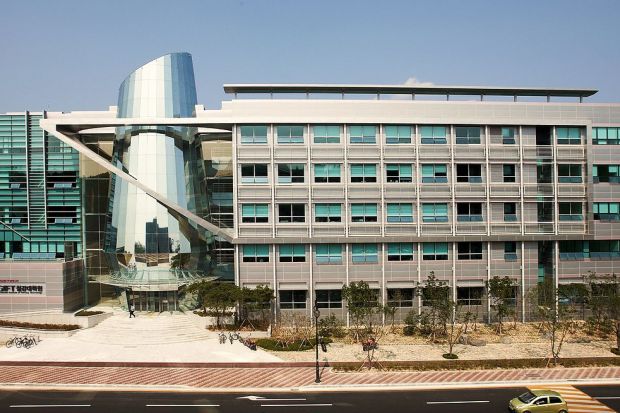POSTECH: Energy Efficient Magnetic Memory Devices Using Topological Materials
Just as the Earth rotates while orbiting around the sun, electrons can be roughly thought as similar as they also rotate while orbiting around the nucleus of an atom. This ‘electron rotation’ is called the intrinsic spin of electron. Recently, a new technology has been developed by using this intrinsic spin of the electrons that drastically lowers the energy consumption in magnetic memory devices.
A research team led by Professor Gil-Ho Lee and Ph.D. candidate Inseob Shin (Department of Physics) has developed a highly efficient spin current-generating heterostructure by combining van der Waals(vdW)-type topological material*1 and magnets. This material is anticipated to be applicable in next-generation magnetic memory devices as it transmits a large amount of spin current despite its small size.
Commonly referred to as “semiconductors” in short, the semiconductor-based memory devices can transmit current using only the properties of the electron charge. However, since electrons not only have charge but also spin, they can also transmit spins. But this property is vulnerable to impurities and can easily disappear, limiting its application to actual devices.
In general, electrons that make up a material each have dissimilar spin directions. When their spin directions are aligned, a property such as magnetization appears. Focusing on this phenomenon, the researchers came up with a groundbreaking idea to use the magnet as a memory device instead of a semiconductor. Unlike semiconductors where information is not stored without a current, magnets retain data simply by changing the spin direction with the magnetic field – without current. In addition, attaching a spin-current inducing metal to the magnet generates and injects a spin current into the magnet, enabling magnetization control. Platinum and tantalum, which are common spin current-generating metals, are usually used as spin-current generating materials.
220208_[그림1] POSTECH 이길호 교수 연구 관련 그림03
In this study, the researchers adopted the tungsten ditelluride (WTe2) – a topological material – instead of platinum and tantalum to dramatically increase the efficiency of spin current generation. The researchers were also successful in improving the issue of spin current loss resulting from the damage at the interface of the magnet and the topological material. To achieve this, the researchers introduced a method of making the heterostructure consisting of magnets and topological materials with atomically flat interfaces by stacking them.
While the spin current conversion efficiency of common metals was only 10%, the results show the newly developed structure reached 500% of efficiency. The current required for magnetization control was also about ten times less than that of previous studies, achieving higher energy efficiency.
“This study has demonstrated the potential of topological materials to play an important role in applications of spintronics,” remarked Professor Gil-Ho Lee on the significance of the study.
Published in Advanced Materials, a leading international journal, this study was conducted with the support from the National Research Foundation, Institute for Basic Science, and the Max Planck Society.

